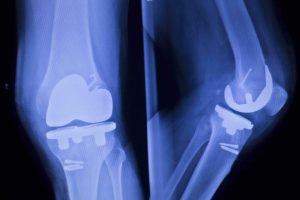REVISION KNEE WITH TIBIAL TUBERCLE OSTEOTOMY
Why get a revision on a total knee replacement?
 Orthopedic surgeons use total knee replacement, or partial knee replacment, as a last resort to restore functionality to a patient knee with end stage arthritic damage that is no longer responding to conservative treatments. However, total knee replacements on average last about twenty years inside of the patient with about ten percent only lasting ten years. Patients may find that their pain starts to return, and the knee starts to lose range of motion. These symptoms indicate wearing out of the replacement and the inflammation that the wearing parts cause as they create debris. The debris from a wearing out knee replacement irritates and can damage the bone that the replacement rests in. To restore function to the knee a surgeon replaces the prosthetic components and removes damaged bone replacing it with additional hardware or bone graft.
Orthopedic surgeons use total knee replacement, or partial knee replacment, as a last resort to restore functionality to a patient knee with end stage arthritic damage that is no longer responding to conservative treatments. However, total knee replacements on average last about twenty years inside of the patient with about ten percent only lasting ten years. Patients may find that their pain starts to return, and the knee starts to lose range of motion. These symptoms indicate wearing out of the replacement and the inflammation that the wearing parts cause as they create debris. The debris from a wearing out knee replacement irritates and can damage the bone that the replacement rests in. To restore function to the knee a surgeon replaces the prosthetic components and removes damaged bone replacing it with additional hardware or bone graft.
Candidates for a revision knee with tibial tubercle osteotomy
Patients that require a total knee replacement revision that have damage to the tibial tubercle from wear and tear may be candidates. Osteotomy means the removal of bone and the tibial tubercle simply means a specific region of the tibia bone. When this specific region incurs damage, a surgeon removes it while revising the knee replacement. This allows the surgeon to remove the old replacement hardware and reconnect new hardware to a stable surface put in place of the removed tibial tubercle.
The Surgery: Revision knee with tibial tubercle osteotomy
Total knee replacement requires an overnight stay in the hospital and a knee revision duplicates the process of a knee replacement but with additional steps to remove the old hardware and repair the load bearing surfaces that the prosthetic anchors to. Medical clearance testing mitigates risk and accurately eliminates many high-risk patients from having a catastrophic result from either the anesthesia or the procedure itself. If postponement of surgery occurs the doctor will explain the steps you need to take to reduce your risk and move forward with the procedure; while frustrating the surgeon does have your best interest in mind based off of a large base of statistical data.
After sedation the surgeon opens the knee and releases the kneecap by cutting away the anchoring point, the tibial tuberosity, to the tibia leaving some bone attached. Then they remove the old hardware and evaluate the bone for reattachment of a new prosthetic. If needed the surgeon cuts new angles into the bone removing the damaged tissue and replaces it if necessary, with bone graft. The surgeon removes a slice of bone from the top of the tibia and replaces it with wedge shaped piece of metal to fill the void. The surgeon drills new anchor holes, applies bone cement, and replaces the prosthetic components. The surgeon then restores the kneecap surface and closes the knee by reattaching the kneecap to the tibia. Closing procedures ensue.
Recovery from a revision knee with tibial tubercle osteotomy
Recovery from a revision knee replacement mirrors the recovery from the initial total knee replacement. After discharge from the hospital most patients return to normal activity in three to six weeks.
Talk to your orthopedic specialists about knee replacement with tibial tubercle osteotomy today! 817-375-5200


